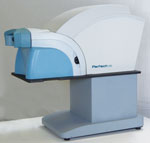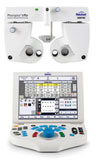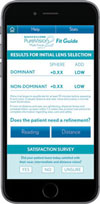 |
Diagnostic Equipment
New Refractor/Autorefractor
A new diagnostic instrument combines wavefront autorefraction and subjective refraction in one space-saving unit, according to Vmax Vision.
The Perfectus raises the gold standard from 20/20 to 20/12 and, in many cases, can be achieved in less than one minute per eye, the company says.
The Perfectus measures a patient’s subjective visual response to a point spread function target, enabling a highly precise refraction to 0.05D—five times more precise than a traditional phoropter, the company says. The refraction corrects for higher-order aberrations and helps prevent over-minus in prescriptions.
Visit www.vmaxvision.com.
 |
Phoroptor Digital Refraction System
A new phoroptor digital refraction system offers fast and quiet lens exchanges, as well as motorized prism compensators and a split cylinder lens to improve testing time for astigmatic correction, according to Reichert Technologies.
The logically arranged keypad and knob, coupled with an intuitive user interface and tilting touchscreen, provide the flexibility to easily access any tests during the exam process. The system also offers integration with both EMR and pre-test equipment, the company says.
Visit www.reichert.com.
Contact Lenses
Progressive Lenses for Digital Eye Strain
Your patients with presbyopia who use digital devices can combat the symptoms of digital eyestrain with a new family of progressive lenses, introduced by Zeiss.
The new lenses account for both the shorter reading distance and increased convergence common when using digital devices, so wearers have a clear and comfortable view of a digital screen, Zeiss says. The new family includes Precision Pure, Precision Plus, Precision Superb and an upgrade to the Individual 2.
 |
Visit www.zeiss.com/vision.
Contact Lens Technology
App for Fitting Multifocal Contact Lenses
Fitting patients with PureVision2 contact lenses for Presbyopia just became a little easier with the new PureVision2 Multi-Focal Fit Guide mobile app from Bausch + Lomb. The app enables you to calculate the initial lens selection by entering the patient’s sphere and cylinder information, including add, based on their most recent refraction, according to the company. Following evaluation, you can determine if further refinement is needed, and the app will provide you feedback and an updated lens recommendation.
It will be extended later this year to include Biotrue Oneday contact lenses for presbyopia.
Visit www.bausch.com.
Mobile Contact Lens Ordering
Some New York and California optometry practices can now offer patients the option of ordering contact lenses for home delivery through a mobile device with WebSystem3’s LensFerry service.
 |
The service includes contact lenses from all manufacturers at your practice’s specified prices, and you receive the sales revenue as if they had been ordered in-office, the company says. All communications are customized for each practice, and you can send the wearer custom-branded email and text reorder reminders through the service, according to WebSystem3.
WebSystem3 plans to introduce the service to additional geographic markets over the coming months.
Visit www.LensFerry.com.
Dilating Solution
Phenylephrine HCl Ophthalmic Solution
A new ophthalmic solution for pupil dilation that is shelf-stable and does not require refrigeration has hit the market. Akorn launched phenylephrine HCl ophthalmic solution 2.5% and 10%, after receiving the product’s New Drug Application (NDA) approval from the FDA in January.
Phenylephrine hydrochloride ophthalmic solution 2.5% is available in 2ml and 15ml fill sizes. The 10% solution is available as a 5ml fill size.
Visit www.akorn.com.
